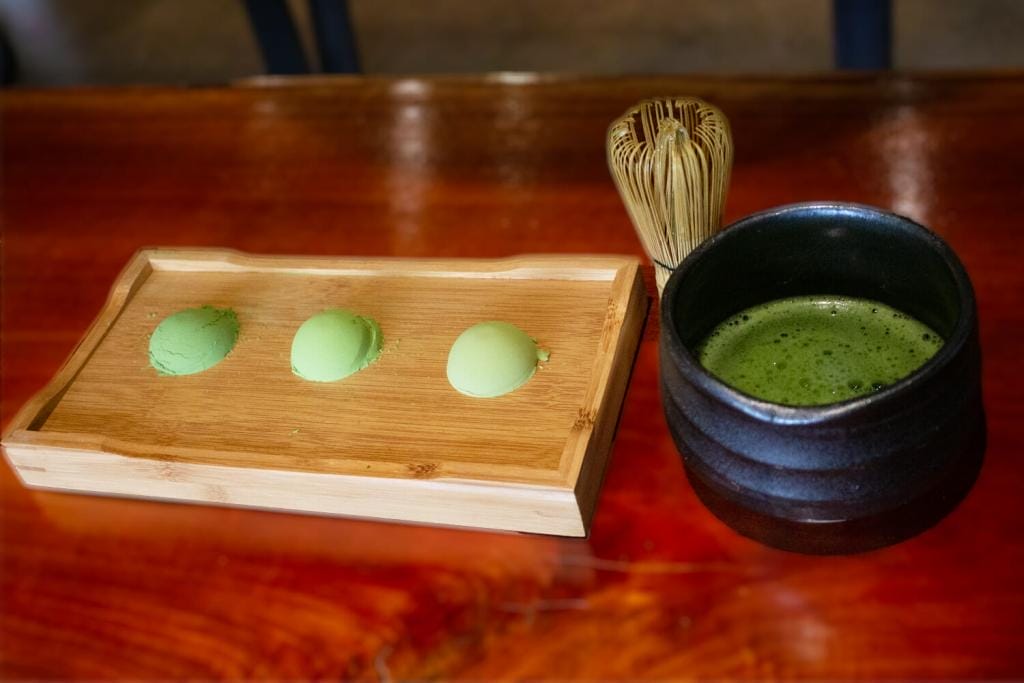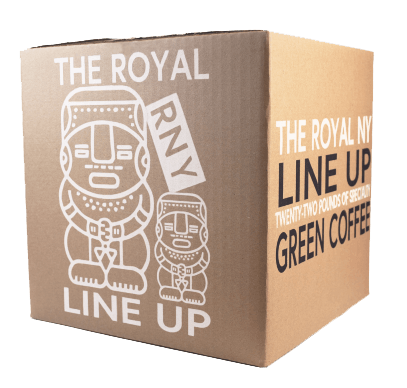No products in the cart.
Tea
In the Cup: How to make Matcha tea
Want to learn how to make matcha tea? Royal New York tea trader Angelica Cordero is here to teach you about the history of matcha and how it should be prepared. From ceremonial grade to culinary grade, from traditional preparation to quick service preparation, she covers it all. Learn more below!
Before you learn how to make Matcha tea

Before you learn how to make Matcha tea, it’s important to understand a bit more about what exactly matcha is and where it comes from.
A brief history of tea in Japan
In the early 800s, Buddhist monks brought tea home to Japan after participating in a religious envoy to China. At this time, China teas were formed into bricks for ease of storing and trade. These bricks would then be ground into a powder and whipped in hot water for consumption. While tea in Japan was initially only accessible to monks and members of nobility, in the 1200s drinking tea started to take off. The 1200s also saw Japan’s first tea gardens established.
By the 1500s, the tea ceremony had taken on a prominent cultural role. In the1600s, tea growers in Uji began shading tea leaves before harvesting, drying, and grinding into powder. This is also the period in which tea rooms and schools were introduced, and the tea ceremony as we know it today has its origins.
Today, drinking tea is a part of daily life for many Japanese people. Hot or cold green tea such as sencha is the most popular for daily consumption at work, school, cafes, and restaurants. Beyond its traditional use in tea ceremony, matcha is a beloved flavor for cakes, pastries, candy, and ice cream. It can also be used in savory dishes such as tempura and soba noodles. Uji in Kyoto is regarded as the home of matcha. It still produces some of the most sought after matcha in the world.
What is Matcha?
Japanese green tea is grown in several prefectures, each focusing in certain processing methods:
Shizuoka is the largest tea producing region and grows sencha, bancha, and some matcha.
Kagoshima is the second largest producer and specializes in organic growing practices. At Royal New York, we import our organic Japanese teas from Kagoshima. This includes our Organic Matcha, Organic Sencha, and Organic Genmaicha.
Mie prefecture is the largest producer of kabusencha
Fukuoka prefecture grows almost half of Japan’s gyokuro.
Kyoto, specifically Uji, has specialized in matcha for hundreds of years.

In the weeks leading up to spring harvest, the tea fields are covered with cloth or screens. This is done so that the plants are not exposed to direct sunlight. In turn, this makes the plant produce more chlorophyll to sustain itself, while also producing less tannins. This results in a vibrant green leaf with minimal astringency. Shade growing is a necessary step to producing matcha.
Matcha Processing
After harvest, green teas are steamed to halt oxidation and preserve their color and fresh taste. Outside of Japan, the terms ‘tencha’ and ‘gyokuro’ tend to be used interchangeably when speaking about matcha. Gyokuro and tencha are made from the same shade grown tea plants but are processed differently. Gyokuro is lightly rolled so that it can be steeped as a loose-leaf tea. Tencha is dried flat so it can be deveined and destemmed easily before it is ground into matcha. Tencha is stored as dried leaves and then ground into matcha. This is done to ensure that the matcha is always as fresh as possible when exported. Traditionally, a stone mill called ishi-usu is used to grind matcha. Stone mills are made of softer stone such as granite to prevent friction heating and potentially ruining the tea.
Today, to meet the growing global demand for matcha, ceramic ball mills and bead mills are also used. These mills can be automated for faster production. Since it is finely ground, matcha has a shorter shelf life than most other teas. Matcha should be consumed within a year of grinding. Additionally, matcha should be stored in a cool, dark, airtight environment to maintain the best flavor and color.
What Makes Matcha Ceremonial?
“Ceremonial grade” and “culinary grade” terminology is not commonly used in Japan. This terminology, however, is common in the states for defining the quality of imported matcha. There is no regulation in or out of Japan that strictly defines whether matcha is of ceremonial quality. Because of this, ceremonial matcha can be simply defined as matcha grown and processed in Japan that is of high enough quality to be enjoyed on its own.
Higher quality, ceremonial grade, matcha will often have a more vibrant green color. However, this is not always the case. Differences in cultivar, terroir, farming practices, and processing can cause variation in matcha’s color. In these terms, culinary or barista grade is better for lattes, smoothies, cooking/baking, and confectionary uses.
How to make Matcha tea

Japanese Tea Ceremony
Powdered tea has been whisked with hot water for centuries, and the Japanese tea ceremony perfected this practice into an art. The elements of a traditional tea ceremony are deeply rooted in Zen Buddhism and the wabi-sabi aesthetic. Everything from the size of the room and decor to the appearance of the brewing equipment is carefully considered when creating a formal environment. Tea gatherings can be informal as well, and there are many initiatives striving to bring tea traditions to a younger audience.
Formal tea ceremonies are held at tea houses or tea rooms with tatami mats and a hearth built into the floor. Appropriate décor includes calligraphy scrolls and flower arrangements, and the host will typically wear a kimono and obi. A less formal gathering can take place anywhere a host is able to prepare tea for seated guests, including outdoors. The type of meal served at the event will also depend on the level of formality. Traditional preparation hinges on the equipment used to make the tea.
Traditional Matcha Preparation
The equipment for traditional preparation is a tea bowl (chawan), bamboo whisk (chasen), and bamboo scoop (chashaku). The host will also use a cloth (chakin) to make sure the tea bowl is dry after warming it and will have the matcha stored in a caddy (natsume). The tea will be sifted ahead of time, but if you are following these steps at home many people like to put the matcha through a sifter (furui) first to ensure that no clumps are formed.
During the tea ceremony or gathering, the host will preheat the chawan with hot water, then wipe it dry with the chakin. Matcha will be measured into the chawan using the chashaku, then hot water will be added. The tea and water will be whisked together with the chasen until fully combined. The tea served can be koicha (thick tea) or usucha (thin tea), again depending on the formality of the event. Koicha uses less water (about 2 grams of matcha to 35mL) and is shared among the guests. Usucha uses a ratio of approximately 1 gram of matcha to 70mL water, and each guest gets their own serving.
Using a bamboo whisk and tea bowl to make matcha at home uses more water. Based on personal preference, most people making matcha at home will use a ratio of 1.5 – 3 grams of matcha per 8 – 12oz water. The whisking motion should come from the wrist, and a ‘W’ or zigzag motion is the best for creating a fine foam. When making matcha, the ideal water temperature should be between 140F and 175F to ensure that the tea does not scald.
Quick Service Matcha Preparation
While interest in matcha has seen some decline in Japan, in the USA demand for matcha has taken off over the past 20 years. Matcha lattes and frappes started popping up on menus in the US in the early 2000s, and for many Americans this was their first foray into the world of matcha. Its popularity steadily increased into the 2010s, when social media platforms such as Instagram launched it even further to become a staple on most café menus. During the pandemic and beyond, an increased interest in wellness products and functional ingredients made matcha a daily must for many.
Traditional preparation is wonderful for tea gatherings and home tea brewing, but it is not ideal for fast paced environments like cafés and drive thrus during the morning rush. Matcha can be measured out with a teaspoon or weighed out on a kitchen scale. Some matcha whisking options for café service are battery operated milk frothers, blenders, and shaker bottles. Even a glass mason jar with a tight lid can make a well blended matcha! The US audience for matcha tends to lean towards serving it with milk or alternative milks as a hot or cold latte, which can be sweetened with sugar, honey, or syrup. Its vibrant green color makes it a beloved ingredient for eye-catching signature drinks, and its flavor pairs well with fruit, flowers, and more decadent options like white chocolate.
Now that you know how to make matcha tea…
It’s time to make sure all of your matcha needs are covered! Shop our matcha offerings below or contact a tea trader to request samples today.



